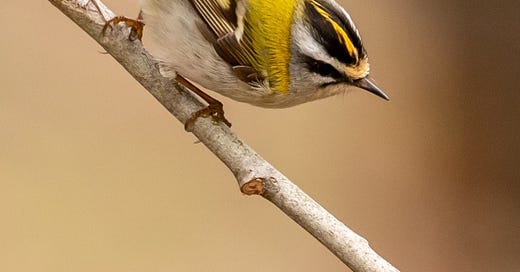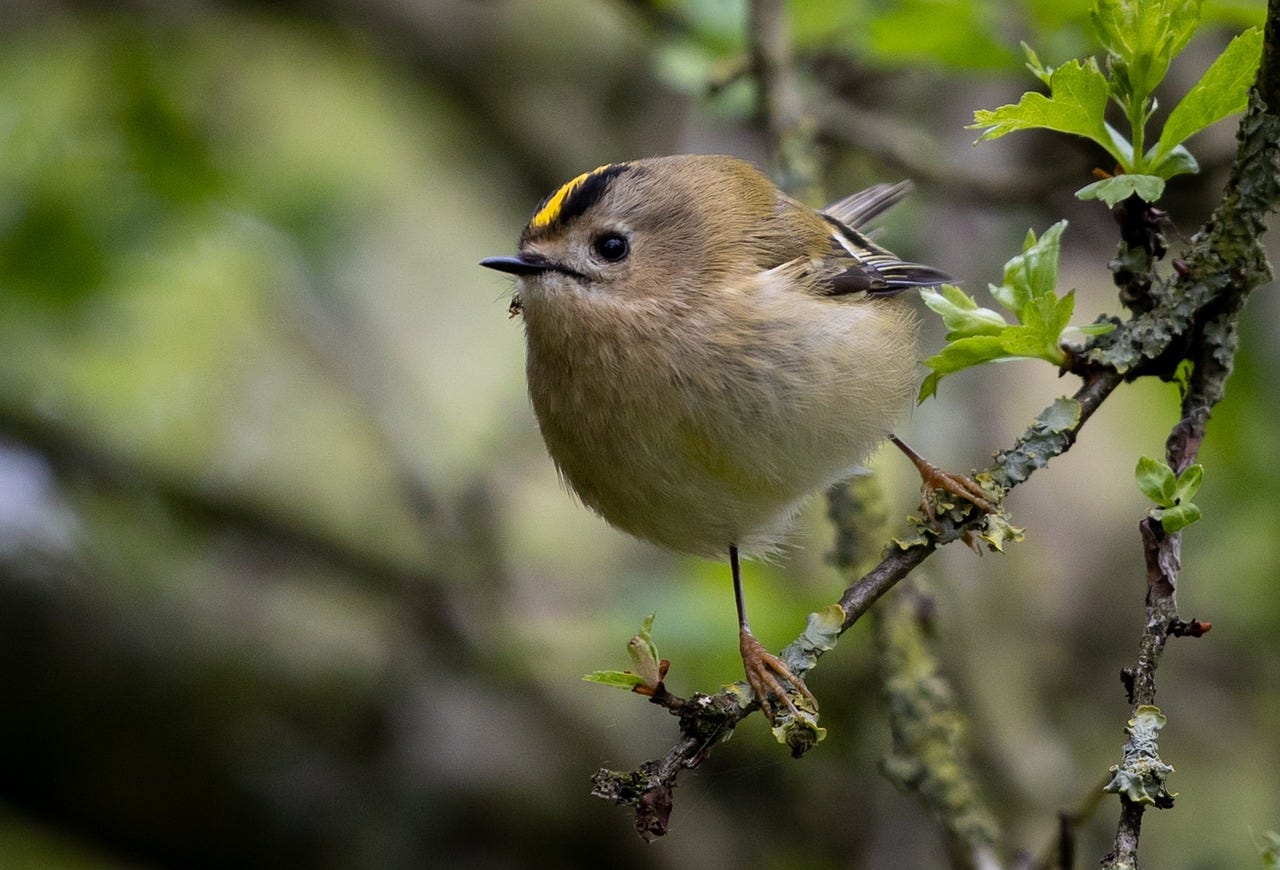Tiny, restless, exquisitely marked, and never common, a close encounter with a firecrest can make your day.
Their simple song is delivered among the boughs, well above head height. It’s a high-pitched peeping, that accelerates and rises very slightly in pitch over the course of around three seconds.
In itself, the song is hardly a prize. But if it leads to a glimpse of what’s making the noise then you win.
Firecrests share the title of smallest bird in Europe with their cousin the goldcrest. But whereas goldcrests have no eyestripe (and an endearingly nonplussed expression), firecrests look sharp - black through the eye, whiteish above and below it, and with a fiery, black-bordered streak on the crown.
Like goldcrests, adult females and males can be told apart by that crown - an even golden yellow in the female, yellow with an orange centre in the male. But this is not always easy to tell in the field, not least because firecrests don’t keep still more than a nanosecond.
Firecrests like to fidget and flit their way through tangled places. For a moment they may appear right in front of you - peeking out from the edge of a thicket or hovering under a leaf to pick off a morsel.
Then they’re gone. Once again, tracking them by ear is often the best way to steal a second look.
Since first being found nesting in the New Forest in 1962, firecrests have gradually spread.
Although they remain scarce, and mainly limited to the south and east of England for now, they appear to be establishing themselves as a breeding species in more and more places - and their requirements are not exactly demanding.
Mature woodland with a mix of evergreen and deciduous trees is good. The scrappy corner of a park or a large wooded garden will do.
Now is the peak time to hear that intensifying song, and not a bad time to clap your eyes on the culprit, before the leaves are fully out.
Advanced-level firecrest-finding
Outside the breeding season, tuning into the firecrest’s subtle everyday noises also greatly increases the chance of seeing one.
Firecrest contact calls are generally made up of unremarkable peeping notes, given one at a time or in a rapid bunch.
At first listen, these sounds are all rather Acme Small Bird - high-pitched twitterings that could easily be another pipsqueak such as a goldcrest or a blue tit.
But every once in a while they give themselves away, with a series of three or four notes that inflect upwards.
In this (quiet) recording you can hear mainly one-note calls given quickly, and sounding rather anonymous - until towards the end you hear two phrases which make the characteristic ascent.
While undeniably subtle, it’s distinctive. Plenty of species deploy descending phrases, especially in song - think chaffinch, treecreeper, willow warbler, meadow pipit, woodlark. Not many head in the other direction.
And in the autumn and winter firecrests might be found almost anywhere. Tuned to that sound, you could happen upon one on a clifftop, along an urban street, or while you’re putting the rubbish out the back door.
Personally I find that extremely motivating.
Also testing the limits of your hearing: Goldcrest
Next week: Nightingale
There’s a Shriek of the Week every Friday (or thereabouts). If you know someone who might like a dose of birdsong in their inbox, please pass this along.
Thanks for reading. May your spring foliage be studded with firecrests.
~ Charlie
Credits:
Firecrest image by Kiril Gruev from Pexel
Goldcrest image by TheOtherKev on Pixabay
Would you like to join me for some live birdsong? See all upcoming Sussex walkshops and online events from Birdsong Academy.







Thanks for bringing attention to this lapidary birdlet to a wider audience. It is perhaps the showiest of the world's kinglets; the patch of orange in the males' crown is often flecked with red and the bronze shoulder patches fairly gleam when exposed to the sun. North America's Golden-crowned Kinglet and Taiwan's Flamecrest (which has the best species moniker in birdom--goodfellowi) come close to matching the Firecrest's colorful sizzle--but to me the latter is fairest of all.
The other factoid worth knowing is the way these birds can survive the coldest winter temperatures, despite averaging only 9 cm in length and weighing about 5-6 grams.
We have a pair of firecrests in our garden down here in the south west. They have a routine which involves popping out for a spot of lunch about 1.30pm and then maybe nipping round the corner for cocktails about 7.30 pm. Once glimpsed never forgotten, but as you say never still. A keen birdwatching friend came over to try and spot them a couple of years ago and sure enough the male came out at lunchtime right on cue, then proceeded to sit for a good minute on the top of a rose bush so my friend could photograph him from the sitting room window. My friend was in ecstasy, the bird has never done it again.